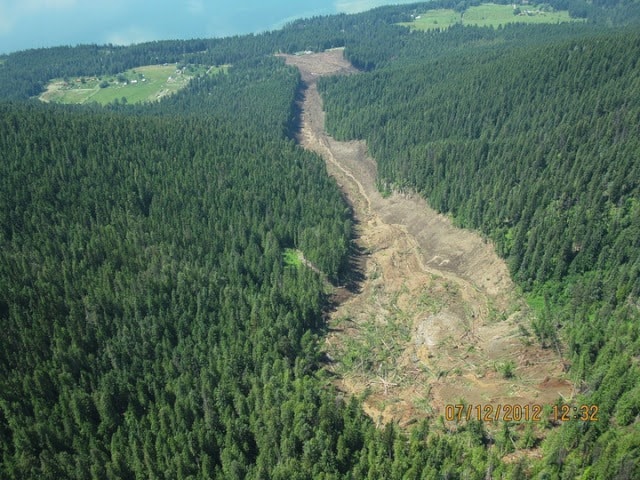First of three parts
Johnsons Landing properties not directly affected by a deadly 2012 landslide have seen a 25 to 50 per cent reduction in their assessed values in recognition of the stigma they face.
Dennis Hickson, deputy assessor with the BC Assessment Authority’s Nelson/Trail branch, says all properties in the north Kootenay Lake community were reduced “quite substantially” on recent notices, but dealt with case-by-case.
While assessments already dropped last year, this year’s notices are the first since a report last May suggested the risk of further landslides remains high and some properties may never be safe to occupy.
“One of the report authors said the impacts are so property-specific that I decided you can’t apply a blanket minus-50 per cent kind of thing,” Hickson explained in an interview.
Seventeen properties fall within one or more hazard zones and several remain under evacuation order. Hickson said he adjusted around 40 properties in all, with those at highest risk brought down to the equivalent of farming values.
“I didn’t have any comparable properties, which is a typical way you appraise properties,” he said. “You have to use experience and judgment in coming up with new values.”
In one of the most dramatic examples, the eight-acre property where Petra Frehse died had a pre-slide assessment of $85,500 for the land and $38,000 for improvements. Now it’s valued at $1,800 for the land and zero for buildings.
 However, establishing values for properties outside high risk areas was more difficult, Hickson said, “because there’s definitely, intuitively, a lot of loss in value attributable to stigma, even though there’s a low probability there’s going to be any slide action impacting those properties. People just want to stay away from them.”
However, establishing values for properties outside high risk areas was more difficult, Hickson said, “because there’s definitely, intuitively, a lot of loss in value attributable to stigma, even though there’s a low probability there’s going to be any slide action impacting those properties. People just want to stay away from them.”
Hickson said he applied up to a 50 per cent reduction for those properties closer to the slide, tapered to 25 per cent further away, based on the stigma factor.
Many properties include acreages and waterfront. The last one adjusted to the north of the slide is 60 acres that in 2012 was assessed at $281,000 but is now pegged at $197,200 — about a 30 per cent reduction, although some of the difference could be chalked up to general market changes.
Hickson said he visited some of the affected properties and attended a couple of community meetings before arriving at the valuations. Then he sent letters to property owners in early December indicating what was intended, hoping to head off any problems before assessment notices went out. He didn’t receive any written responses and as of last week had only had one phone call.
But if property owners do have concerns, Hickson encouraged them to get in touch. “Given that there’s a lot of qualitative adjustments here, we’d like to discuss it with them before we go into formal appeal,” he said.
Hickson doesn’t think the reduced assessments — which are localized to Johnsons Landing and don’t extend as far north as Argenta — will have much effect on overall taxation within Area D of the Regional District of Central Kootenay.
“The decrease in value from the 40 properties will be insignificant in terms of taxation increase to other properties,” he said.
Regional district administrator Brian Carruthers agreed: “I imagine it wouldn’t be huge. The only way we’ll know is by running the numbers once we get the final assessment roll in March. Later in our budget cycle, we’ll see the impact.”
The slide on July 12, 2012 sent 320,000 cubic meters of debris down Gar Creek, claiming four lives and destroying five homes.
Next: Property owners react
